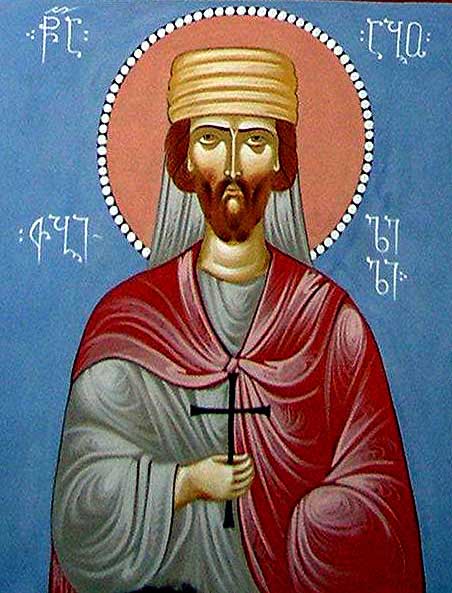 The martyr Abu al-Attar was an Arab Muslim from Baghdad. He was seventeen years old when he met a Georgian prince, Duke Narses. He came to Baghdad on the orders of Caliph Abu Jaafar al-Mansur, who had imprisoned him in a hole for three years. When al-Mahdi (775-785) took over the caliphate, he ordered him to be released, restored his reputation, and returned him as a prince over his people. Abu al-Attar accompanied the prince to his country after joining his entourage. Abu al-Attar learned to read and write the Georgian language, and became familiar with the Old and New Testaments. He began to enter church regularly and question the teachers on matters of faith. Little by little, he became aware of the faith and teachings of the Holy Church, and he accepted Christ in his heart as Lord without declaring it publicly for fear of being persecuted by the Muslims.
The martyr Abu al-Attar was an Arab Muslim from Baghdad. He was seventeen years old when he met a Georgian prince, Duke Narses. He came to Baghdad on the orders of Caliph Abu Jaafar al-Mansur, who had imprisoned him in a hole for three years. When al-Mahdi (775-785) took over the caliphate, he ordered him to be released, restored his reputation, and returned him as a prince over his people. Abu al-Attar accompanied the prince to his country after joining his entourage. Abu al-Attar learned to read and write the Georgian language, and became familiar with the Old and New Testaments. He began to enter church regularly and question the teachers on matters of faith. Little by little, he became aware of the faith and teachings of the Holy Church, and he accepted Christ in his heart as Lord without declaring it publicly for fear of being persecuted by the Muslims.
After several years, the Abbasids became angry with Narses again, so he fled from them to the Caucasus. Narses was accompanied on his journey by three hundred men, including Abu al-Attar. There in the Caucasus were a number of Christian towns and villages, so Abu al-Attar was baptized by the priests of that country. After that, the prince and his entourage moved to the Christian land of Abkhazia.
After some time, the Abbasids returned and asked Narses to return to his country. When he was about to return, he summoned the Abkhazian prince Abu al-Attar and invited him to stay in Abkhazia because he would expose himself to destruction if he returned to Tbilisi, Georgia, as he was known as an Arab Muslim and the Muslims were the masters of the place. Abu al-Attar replied: “Now that Christ has bestowed His mercy upon me and freed me from the darkness of my first ignorance and qualified me to be baptized in His name, there is nothing that would force me to deny Him. Even if they give me sums of gold and silver or interrogate me with torture and flogging, they will not be able to take away the love of my Savior from me…”
When Narcissus and his companions reached Tbilisi, the Muslims learned that Abu al-Attar had become a Christian, so some cursed him and harassed him. But he remained steadfast in his faith. Abu al-Attar spent three years openly in the city and villages, during which no one laid a hand on him. The God-loving people provided him with all the food and clothing he needed.
In late 785, Abu al-Attar was arrested. However, Stephen, the new Georgian prince, intervened and released him. A few days later, he was arrested again after a new judge arrived in the city. Some Muslims came and offered the judge that Abu al-Attar should return to Islam or be killed because he was preaching the good news to Muslims about Christ. When Abu al-Attar stood before the judge, the latter tried to convert him to the religion of his fathers with kind words, but failed. He then offered him a large sum of money, but he refused. The judge then ordered him to be chained and imprisoned. This was on December 27, 785 AD.
Abu al-Attar remained in prison for ten days, which he spent in prayer and fasting. During this period, some Muslims tried in various ways to dissuade him from his intention, but they failed. On January 6, 786 AD, Abu al-Attar was taken before the judge, who offered him Islam as a religion, but he refused and ordered his head to be cut off. Immediately, the man of God was taken outside to the palace garden and his head was cut off. Muslims arrived, took the body and the head, swept away the blood-soaked dirt and everything related to the martyr, and burned everything in a place known as the Place of Lamentation. Then they took the bones, put them in a bag, and threw them into the sea, so as not to give the Christians the opportunity to bury the martyr with honor or to be blessed by his remains.
The Holy Church commemorates him on January 8. His biography was written after his martyrdom by John Ben Shaban Al-Georgi.


